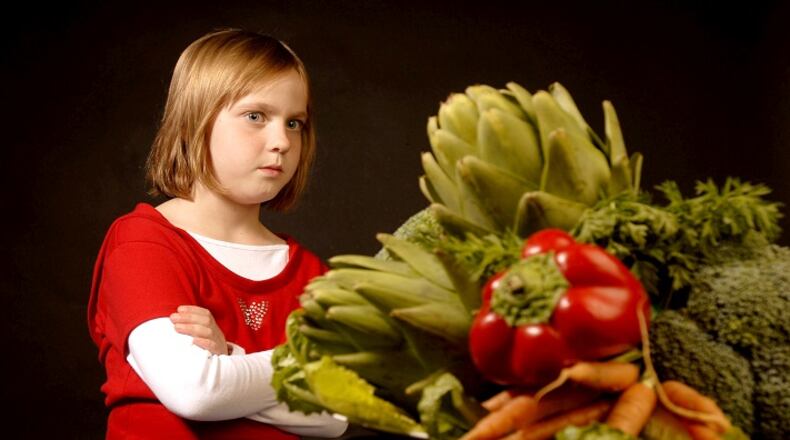Most parents have fought the battle of kids vs veggies.
New research from Kansas State University finds what a mom eats during pregnancy can make a big difference.
Children's tastes start being shaped while they are still in the womb, according to Richard Rosenkranz, KU associate professor of food, nutrition, dietetics and health.
"During pregnancy, an embryo and then a fetus is obtaining information about the outside world," Rosenkranz said. "So, moms can set the stage for what their kids will want to eat before they're even born."
Infants can learn through repeated exposure and dietary variety. So Rosenkranz suggests focusing more on a child's willingness to consume a food rather than relying on the facial expressions they give when eating it. For example, some infants may frown at bitter vegetables, but if they still swallow the food, their desire toward the food can be increased over time by continuing to serve it to them.
Babies as young as 6 months can detect what eating behaviors are normal and abnormal, Rosenkranz said. They react when their parents eat foods they don't usually eat, and they take cues from parents as to what is and isn't desirable.
"Babies start to think, 'Why does he keep putting this stuff in front of me, but he never eats it?'" Rosenkranz said. "We're being watched by our kids from very young ages."
Rosenkranz suggests parents take advantage of watching eyes by eating vegetables similar to the ones they serve their babies and toddlers. He advises starting with sweeter vegetables like corn and carrots because people of all ages generally prefer sweeter foods. To develop toddlers' growing tactile and fine motor skills, parents can chop carrots into bitesize pieces and encourage toddlers to pick up corn kernel by kernel.
Young school-aged children are more likely to eat veggies that are cut and arranged into smiley faces or animals than served plain in a bowl.
"If you cut fresh vegetables into fun shapes or use grape tomatoes for eyes, suddenly the kids are taking something healthy they never would have eaten and actually enjoying it," Rosenkranz said.
Involve children in cooking and food preparation as early as kindergarten and increasing their roles in the kitchen as they grow. Research shows a direct connection between food preparation and vegetable consumption, so if children can help prepare veggies in the kitchen, grow them in the garden or select them at the grocery store, they will likely eat more of them.
As children get older, their vegetable consumption tends to decrease, with the lowest consumption found in teenagers. One way to increase teenagers' vegetable consumption is to provide fully prepared vegetables in easy-to-access places. For example, parents could make sure a vegetable tray with dip is sitting on the counter when teens come home from school, or they could have a grab-and-go vegetable conspicuously placed in the refrigerator.
Q and A
Q: Is matcha tea something I should include in my diet?
A: Matcha is a Japanese-style green tea made from tea leaves that are ground into a fine powder, which is then dissolved into hot water or milk. This contrasts from most teas, in which the leaves are steeped in hot liquid and then removed. Though matcha tea dates back over 900 years and has a long tradition in Zen Buddhism, it has gained significant popularity recently as it is included in "tea lattes" in coffeehouses, other flavored drinks, including beer, and even foods, such as breads and desserts. The health benefits of green tea, such as heart health and cancer protection due to its high antioxidant content, are well known and largely accepted, so it follows that matcha tea also has benefits. Green tea contains significant amounts of catechins, an antioxidant in the flavonoid family that also includes isoflavones found in soy and anthocyanins in blueberries. One study found that matcha tea had more than three times the catechin content of the next highest green tea, which is impressive. But another study found that catechin content varied greatly by manufacturer and batch. So, while matcha can be a healthy part of one's diet, it's still important to have varied sources of antioxidants from whole foods. - Environmental Nutrition.
RECIPE
A lean, skinless chicken breast half contains 182 calories and 4 grams of fat (only 1.1 grams saturated fat). IT's a great source of protein as well. But sometimes, we need some inspiration for the familiar chicken. Here's a recipe from Cooking Light to make an everyday meal special.
Tandoori-Spiced Chicken
1 1/2 cups plain 2 percent reduced-fat Greek yogurt
2 tablespoons grated onion
1 tablespoon grated peeled fresh ginger
1 tablespoon canola oil
1 teaspoon ground cumin
1/2 teaspoon ground red pepper
1/4 teaspoon ground turmeric
3 garlic cloves, minced
4 (6-ounce) skinless, boneless chicken breast halves
1/2 teaspoon salt
Cooking spray
Combine first 8 ingredients in a heavy-duty zip-top plastic bag. Add chicken to bag; seal. Marinate in refrigerator 2 hours, turning occasionally. Place a small roasting pan in oven. Preheat broiler to high. Remove chicken from bag; discard marinade. Sprinkle both sides of chicken evenly with salt. Place chicken on preheated pan coated with cooking spray. Broil in lower third of oven 15 minutes or until done, turning after 7 minutes. Yield: 4 servings (serving size: 1 breast half).
Per serving: 152 calories, 30.4 g protein, .7 g carbohydrate, 2.2 g fat, 74 mg cholesterol, .1 g fiber, 381 mg sodium.
About the Author
The Latest
Featured

